
John Maurice of Nassau, called "the Brazilian" for his fruitful period as governor of Dutch Brazil, was Count and Prince of Nassau-Siegen. He served as Herrenmeister of the Order of Saint John from 1652 until his death in 1679.
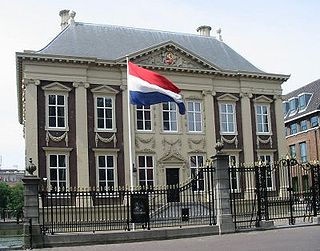
Jacob van Campen was a Dutch artist and architect of the Golden Age.
Joannes or Johannes De Laet was a Dutch geographer and director of the Dutch West India Company. Philip Burden called his History of the New World, "...arguably the finest description of the Americas published in the seventeenth century" and "...one of the foundation maps of Canada". De Laet was the first to print maps with the names Manhattan, New Amsterdam and Massachusetts.
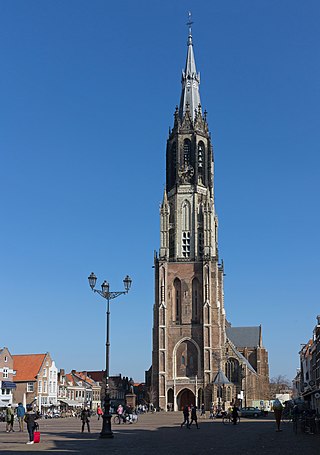
The Nieuwe Kerk is a Protestant church in the city of Delft in the Netherlands. The building is located on Delft Market Square (Markt), opposite to the City Hall. In 1584, William the Silent was entombed here in a mausoleum designed by Hendrick and Pieter de Keyser. Since then members of the House of Orange-Nassau have been entombed in the royal crypt. The latest are Queen Juliana and her husband Prince Bernhard in 2004. The private royal family crypt is not open to the public. The church tower, with the most recent recreation of the spire which was designed by Pierre Cuypers and completed in 1872, is the second highest in the Netherlands, after the Domtoren in Utrecht.
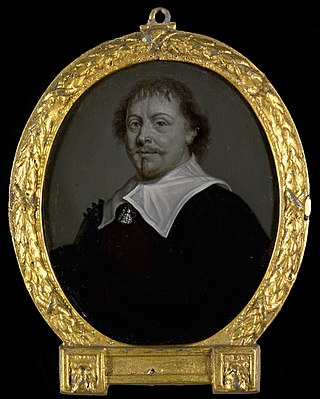
Franciscus Plante was a Dutch poet and chaplain.

Dutch Brazil, also known as New Holland, was a colony of the Dutch Republic in the northeastern portion of modern-day Brazil, controlled from 1630 to 1654 during Dutch colonization of the Americas. The main cities of the colony were the capital Mauritsstad, Frederikstadt, Nieuw Amsterdam (Natal), Saint Louis, São Cristóvão, Fort Schoonenborch (Fortaleza), Sirinhaém, and Olinda.

Georg Marcgrave was a German naturalist and astronomer, whose posthumously published Historia Naturalis Brasiliae was a major contribution to early modern science.

Frans Janszoon Post was a painter during the Dutch Golden Age. He was the first European artist to paint landscapes of the Americas, during and after the period of Dutch Brazil. In 1636 he traveled to Dutch Brazil in northeast of South America at the invitation of the governor Johan Maurits van Nassau-Siegen. His works were widely collected in The Netherlands, Europe, and Brazil, with the works showing an idealized vision of Dutch colonial rule.
Albert Eckhout (c.1610–1665) was a Dutch portrait and still life painter. Eckhout, the son of Albert Eckhourt and Marryen Roeleffs, was born in Groningen, but his training as an artist and early career are unknown. A majority of the works attributed to him are unsigned. He was among the first European artists to paint scenes from the New World. He was in the entourage of the Dutch governor-general of Brazil, Johan Maurits, Prince of Nassau-Siegen, who took him and fellow painter Frans Post to Dutch Brazil to have them record the country's landscape, inhabitants, flora and fauna. Eckhout is also famous for his still-life paintings of Brazilian fruits and vegetables. His paintings were intended for decoration in a domestic context.

Willem Piso was a Dutch physician and naturalist who participated as an expedition doctor in Dutch Brazil from 1637 – 1644, sponsored by count Johan Maurits van Nassau-Siegen and the Dutch West India Company. Piso became one of the founders of tropical medicine.

Historia Naturalis Brasiliae, originally written in Latin, is the first scientific work on the natural history of Brazil, written by Dutch naturalist Willem Piso and containing research done by the German scientist Georg Marcgraf, published in 1648. The work includes observations made by the German naturalist H. Gralitzio, in addition to humanist Johannes de Laet. It was dedicated to Johan Maurits, Count of Nassau, who was the patron of the project during the period of Dutch rule in Brazil.
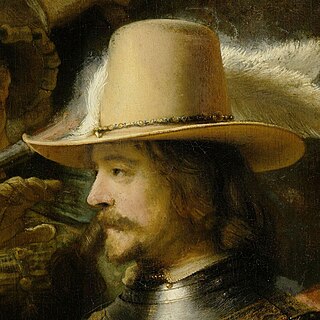
Willem van Ruytenburch, lord of Vlaardingen and Vlaardingen-Ambacht (1600–1652) was a member of the Dutch gentry and Amsterdam patriciate of the Dutch Golden Age. He became an alderman of Amsterdam and joined the Schutterij of Frans Banninck Cocq. Willem was featured, as a lieutenant, in Rembrandt's 1642 painting The Night Watch for which he is now probably most famous.
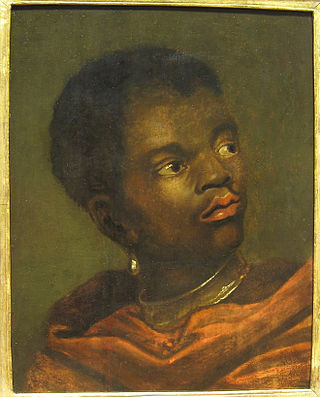
Representations of slavery in European art date back to ancient times. They show slaves of varied ethnicity, white as well as black.
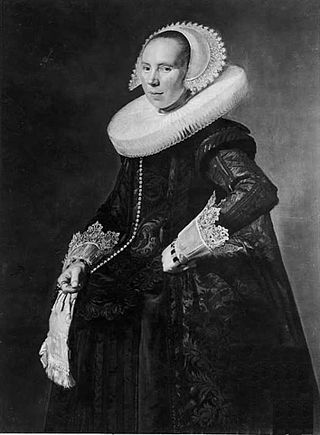
Portrait of Cunera van Baersdorp is an oil-on-panel painting by the Dutch Golden Age painter Frans Hals, painted in 1625 and now in a private collection. It is considered a pendant portrait to the Portrait of a Man Standing, now identified as Cunera's husband Michiel de Wael.

Portrait of Dom Miguel de Castro, Emissary of Congo is a 1643 painting by the Dutch Golden Age painter Jasper or Jeronimus Becx. It was earlier attributed to Albert Eckhout.

Jan Kooi was a Dutch KNIL military officer from Ghana.
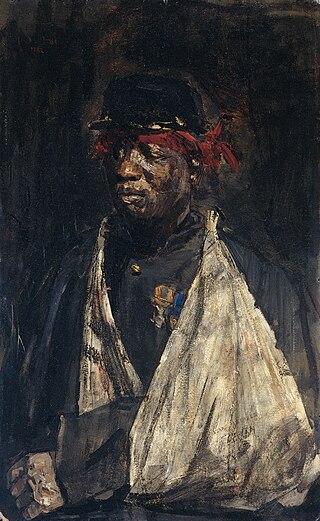
Portrait of a Wounded KNIL Soldier is an Amsterdam impressionist portrait painting by Isaac Israëls, signed and dated to 1882. It has been in the Rijksmuseum since 2000.

Portrait of a Black Man with a Sword is a circa 1640s Flemish School painting which Sotheby's last sold in London for GDP 34,850 in 2011.

The Sibyl Agrippina is a circa 1630s oil painting of a Black woman in the guise of the Sibyl Agrippina. The painting is one of a series of Sybils by Jan van den Hoecke, only recently being re-attributed after being known as an early portrait of an African woman by Abraham Janssens. It is held in the Museum Kunstpalast in Düsseldorf.

Brazil—Netherlands relations refers to the bilateral relationship between Brazil and the Netherlands. Brazil has an embassy in The Hague and a consulate in Amsterdam, and the Netherlands is represented by an embassy in Brasília and consulates in Belém, Belo Horizonte, Curitiba, Fortaleza, Manaus, Natal, Porto Alegre, Recife, Salvador, Rio de Janeiro, Santos, São Paulo and Vila Velha.





















